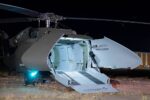AeroVironment has unveiled its latest loitering munition—the Switchblade 400—at the Association of the United States Army (AUSA) Annual Meeting & Exposition in Washington D.C. This new system aims to deliver precision anti-armor effects at extended ranges from a man-portable platform, pushing lethal capabilities down to the small unit level. The Switchblade 400 represents a significant evolution from earlier variants in both range and payload.
From Tactical ISR to Precision Strike: Evolution of the Switchblade Family
The Switchblade family of loitering munitions has evolved significantly since its initial deployment over a decade ago. The original Switchblade 300, introduced in the early 2010s and widely used by U.S. and allied forces in Afghanistan and later Ukraine, was primarily designed for tactical ISR and light anti-personnel strike roles. Weighing just over 2.5 kg with an endurance of around 15 minutes and a range under 10 km, it was optimized for portability and rapid deployment.
The Switchblade 600, introduced in the late 2010s, shifted focus toward heavier targets such as armored vehicles. With a larger warhead comparable to Javelin-class munitions and a range exceeding 40 km, it was intended for brigade-level or special operations use but required more logistical support due to its size (~23 kg).
The newly revealed Switchblade 400 fills a critical capability gap between these two systems—offering squad-portable dimensions with sufficient kinetic effect against light armor or fortified positions.
Switchblade 400 Specifications and Capabilities
According to AeroVironment’s AUSA presentation materials and confirmed by defense media sources including Janes and Breaking Defense, key specifications of the Switchblade 400 include:
- Weight: Approximately 9–10 kg, including launch tube
- Range: Up to 30 km
- Endurance: ~30 minutes loiter time
- Warhead: Dual-purpose blast-fragmentation/anti-armor charge (estimated ~1.5–2 kg)
- Guidance: EO/IR seeker with GPS/INS navigation; human-in-the-loop terminal control via tablet
- Launch Platform: Man-portable tube launcher; vehicle integration optional
- CUI-compliant datalink: Secure communications with jam-resistant link architecture (likely Link-16 or equivalent)
This configuration allows dismounted infantry squads or small units to engage enemy armor or hardened positions without relying on artillery or close air support—a major shift in distributed lethality doctrine.
Tactical Implications for Infantry Units
The introduction of a squad-deployable loitering munition with anti-armor capability represents a doctrinal shift toward decentralized strike power in multi-domain operations (MDO). In contested environments where traditional fires may be unavailable due to EW threats or denied airspace, systems like the Switchblade 400 provide organic precision strike options.
This aligns with U.S. Army modernization priorities under Project Convergence and aligns with NATO’s broader push toward agile C4ISR-enabled formations capable of independent action. By equipping squads with tools previously reserved for higher echelons—such as ATGMs or UAV-delivered munitions—the battlefield becomes more fluid and less reliant on hierarchical fire request chains.
AeroVironment’s Modular Approach and Export Potential
AeroVironment emphasized modularity during its AUSA demonstration. The Switchblade 400 shares common ground control elements with other AeroVironment systems like Puma UAS and Jump20 ISR drones—reducing training burden across platforms.
The company also hinted at potential export interest from NATO allies seeking man-portable precision strike capabilities amid rising demand driven by lessons learned in Ukraine. Countries such as Poland, Estonia, Norway, and Taiwan are likely candidates given their investment in drone-centric asymmetric defenses against armored threats.
Lethality Meets Portability: Bridging Capability Gaps on Future Battlefields
The Switchblade 400 is not just another iteration—it reflects evolving operational realities where contested logistics, peer adversaries, and urban warfare demand flexible tools that empower small units without sacrificing punch.
If successfully fielded at scale—and integrated into joint fires networks—the system could redefine how infantry fights across dispersed battlefields from Eastern Europe to the Indo-Pacific theater.
Sourcing & Program Status
AeroVironment has not disclosed full production timelines but indicated that low-rate initial production (LRIP) could begin as early as mid-2026 pending U.S. Army evaluation trials scheduled for Q1–Q2 FY26 under Rapid Capabilities Office oversight.
No formal procurement contract has been announced yet; however, sources suggest that elements of U.S. Special Operations Command (SOCOM) have requested early user assessments under Other Transaction Authority (OTA) frameworks—a common path for fast-tracking emerging tech into operational test cycles.
Conclusion: A New Era of Squad-Level Precision Fires?
The debut of the Switchblade 400 at AUSA underscores how loitering munitions are reshaping force design from top to bottom—not just enabling long-range strikes but empowering squads with autonomous kill chains once thought impossible below battalion level.
If proven effective in trials and adopted widely, this platform could become a cornerstone of future infantry lethality packages across NATO-aligned forces facing near-peer threats.










